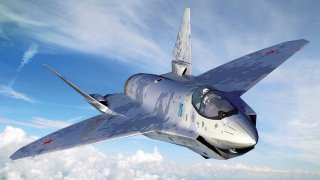Su-75 Checkmate: 5 Reasons Russia's Cheap Stealth Fighter Is a Fraud
Russia's Su-75 Checkmate stealth fighter was pitched as a low-cost alternative to the F-22 and other stealth platforms. And yet, it may never fly.
In 2021 at the MAKS air show with Russian President Vladimir Putin in attendance, the Sukhoi Design Bureau officially unveiled its Su-75 "Checkmate" Light Tactical Aircraft.
The company touted it as a low-cost export aircraft to compete with the American-designed Lockheed Martin F-35 Lightning II, Swedish JAS-39 Gripen, and China's Shengyang FC-31.
The Kremlin announced that it would produce some 300 aircraft over the next 15 years and that several prototypes were being manufactured at the Komsomolsk-on-Amur Aircraft Plant, where the Sukhoi Su-57 (NATO reporting name "Felon") is manufactured.
Su-75 Checkmate: Already Setup to Fail?
Yet, we shouldn't hold our proverbial breath waiting for the Checkmate. Here are five reasons why:
Test Flights Have Repeatedly Been Delayed
It was nearly a year and a half ago that Deputy Minister of the Russian Federation Denis Manturov told reporters that the first flight of the Su-75 won't likely occur until the summer of 2023.
"Changes were made to the design, which corrected the time of the first flight. But at the same time, the principle of modularity and modern digital technologies made it possible to make these changes in the shortest possible time, and as early as 2024 we plan to start flight tests," explained Manturov, who serves as Minister of Industry and Commerce.
Well, that was confusing, but the important takeaway is that 2024 is now just weeks away and the Checkmate still has yet to make its maiden flight.
It Continues to Evolve
As previously reported, the design is typical of a fifth-generation fighter, with diverterless supersonic inlets, internal weapons bays, and radar-absorbent coating all designed to reduce radar cross-section (RCS) and make the Checkmate a stealthy fighter. Inside, the cockpit appears to be laid out almost identically to the Sukhoi Su-57, Russia's highly-touted fifth-generation fighter – which hasn't been produced in any significant numbers.
The Su-75's avionics include active electronically scanned array radar, a must in modern fighters as well as open architecture code which greatly eases the update process.
However, AviationWeek reported in June that the Checkmate's design has changed since the prototype was unveiled. This has included enlarged flaperons on the rear wing edge, while the wing leading-edge root extensions are slightly longer. The outer wing panels previously taken directly from the Su-57 had been significantly modified. In addition, the tail section of the fuselage has been modified.
Such changes from a prototype to production aircraft aren't uncommon – yet, rarely do these speed the development. If anything, this could further impede what little progress has been made on the Checkmate.
Su-75: Analysts Have Described it as "Vaporware"
It was back in January 2022 that John V. Parachini, senior international defense researcher and former director of RAND Research Institute's Intelligence Policy Center, suggested that the Checkmate was little more than "vaporware marketing" – referencing software and hardware that never materializes after introduced often with much fanfare.
He noted that the Sukhoi Design Bureau pulled out all the stops to hype the aircraft, including offering "limited edition" bottles of Checkmate perform.
"No fragrance, however, will mask how the Su-75 isn't a light tactical fighter as advertised, but rather a medium-weight fighter-bomber similar to the F-16V," Parachini wrote at the time.
Moscow Can't Find Any Foreign Partners
Soon after the program was announced Russia began to seek out potential foreign buyers – as well as developmental partners – for the Su-75 Checkmate. In November 2021, Rostec held talks with Emirati businesses to co-produce the Checkmate, but less than a year later, the UAE pulled out of the program, which likely dried up a critical source of funding.
Earlier this year, Moscow made a final move at the Aero India 2023 International Air Show with plans to discuss potential collaboration with India in developing the fighter. However, it appeared that New Delhi had little to no interest in partnering on the program.
At the same time, the orders haven't lined up!
Sanctions Remain
Given the global economic sanctions imposed on Russia, since it launched its unprovoked and unwarranted invasion of Ukraine nearly two years ago, it is unlikely that Moscow will even be able to serially produce the Checkmate in significant numbers.
It further remains unclear if any nation would be eager to purchase it. One factor that could play a role would be whether Moscow would be able to supply the parts to keep the aircraft in the skies. Another issue is that Russia's track record with military hardware has certainly been tarnished due to its failure to defeat Ukraine, while the Kremlin's supposedly advanced aircraft have failed to achieve air superiority.
The final consideration is whether the Su-75 "Checkmate" can truly be described as a fifth-generation fighter. It is based on the Sukhoi Su-57, which many analysts would define as a fourth-generation plus (or 4.5-generation) aircraft in terms of performance.
Russia may be finally forced to admit it is facing a "Checkmate" for the entire program.
Author Experience and Expertise
Peter Suciu is a Michigan-based writer. He has contributed to more than four dozen magazines, newspapers, and websites with over 3,200 published pieces over a twenty-year career in journalism. He regularly writes about military hardware, firearms history, cybersecurity, politics, and international affairs. Peter is also a Contributing Writer for Forbes and Clearance Jobs. You can follow him on Twitter: @PeterSuciu.


